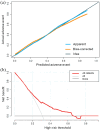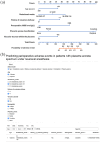Development of a predictive model for severe peripartum hemorrhage in placenta accreta spectrum cases under neuraxial anesthesia: a multicenter retrospective analysis
- PMID: 39944151
- PMCID: PMC11815799
- DOI: 10.1177/26334941251317644
Development of a predictive model for severe peripartum hemorrhage in placenta accreta spectrum cases under neuraxial anesthesia: a multicenter retrospective analysis
Abstract
Background: The placenta accreta spectrum (PAS) represents a significant risk factor for severe postpartum hemorrhage. Recent studies have demonstrated the safety of neuraxial anesthesia (NA) in cesarean delivery (CD) for patients with PAS.
Objectives: To evaluate the risk of severe peripartum hemorrhage in patients with PAS who underwent CD under NA.
Design: A multicenter retrospective cohort study.
Methods: This study analyzed 214 patients diagnosed with PAS. Logistic regression was used to identify factors increasing the risk of severe peripartum hemorrhage. A total of six machine learning (ML) algorithms were employed for model validation.
Results: The predictive model includes the following risk factors: age at delivery >33 years (p = 0.004), history of CD >1 (p = 0.020), preoperative HGB ⩽ 100 g/L (p = 0.013), placenta previa classification (p = 0.001), vascular lacunae within the placenta (p = 0.015), and labor duration (p = 0.026). The validation of ML algorithms revealed that the model achieved an accuracy ranging from 0.68 to 0.71, with an area under the receiver operating characteristic curve between 0.75 and 0.79. A nomogram list and web-based calculator were constructed for clinical implementation, and a risk stratification system was established based on model scores.
Conclusion: A prenatal risk assessment model was developed to estimate the likelihood of severe peripartum hemorrhage in PAS patients undergoing CD under NA. This model may provide preliminary support for clinicians in tailoring anesthetic management strategies for potentially high-risk cases, but further studies are needed to confirm its clinical utility.
Keywords: cesarean delivery; machine learning; neuraxial anesthesia; placenta accreta spectrum; predictive model.
© The Author(s), 2025.
Figures




Similar articles
-
A novel approach for the early prediction and prevention of placenta accreta spectrum and severe peripartum hemorrhage in patients with complete placenta previa: leveraging three-dimensional placental topography, cervical length, and dilatation parameters on magnetic resonance imaging.BMC Pregnancy Childbirth. 2024 Nov 25;24(1):784. doi: 10.1186/s12884-024-06996-w. BMC Pregnancy Childbirth. 2024. PMID: 39587553 Free PMC article.
-
Nomogram based on clinical characteristics and ultrasound indicators for predicting severe postpartum hemorrhage in patients with anterior placenta previa combined with previous cesarean section: a retrospective case-control study.BMC Pregnancy Childbirth. 2024 Aug 31;24(1):572. doi: 10.1186/s12884-024-06706-6. BMC Pregnancy Childbirth. 2024. PMID: 39217290 Free PMC article.
-
Determinants of emergency Cesarean delivery in pregnancies complicated by placenta previa with or without placenta accreta spectrum disorder: analysis of ADoPAD cohort.Ultrasound Obstet Gynecol. 2024 Feb;63(2):243-250. doi: 10.1002/uog.27465. Ultrasound Obstet Gynecol. 2024. PMID: 37698306
-
Development and validation of MRI-based scoring models for predicting placental invasiveness in high-risk women for placenta accreta spectrum.Eur Radiol. 2024 Feb;34(2):957-969. doi: 10.1007/s00330-023-10058-8. Epub 2023 Aug 17. Eur Radiol. 2024. PMID: 37589907
-
Clinical evaluation of the effect for prophylactic balloon occlusion in pregnancies complicated with placenta accreta spectrum disorder: A systematic review and meta-analysis.Int J Gynaecol Obstet. 2024 Oct;167(1):109-127. doi: 10.1002/ijgo.15704. Epub 2024 Jun 20. Int J Gynaecol Obstet. 2024. PMID: 38899567
References
-
- Jauniaux E, Bhide A, Kennedy A, et al.. FIGO consensus guidelines on placenta accreta spectrum disorders: prenatal diagnosis and screening. Int J Gynaecol Obstet 2018; 140: 274–280. - PubMed
-
- Einerson BD, Weiniger CF. Placenta accreta spectrum disorder: updates on anesthetic and surgical management strategies. Int J Obstet Anesth 2021; 46: 102975. - PubMed
-
- Salmanian B, Fox KA, Arian SE, et al.. In vitro fertilization as an independent risk factor for placenta accreta spectrum. Am J Obstet Gynecol 2020; 223: 568.e1–568.e5. - PubMed
-
- Nieto AJ, Echavarría MP, Carvajal JA, et al.. Placenta accreta: importance of a multidisciplinary approach in the Colombian hospital setting. J Matern Fetal Neonatal Med 2020; 33: 1321–1329. - PubMed
-
- Wu S, Kocherginsky M, Hibbard JU. Abnormal placentation: twenty-year analysis. Am J Obstet Gynecol 2005; 192: 1458–1461. - PubMed
LinkOut - more resources
Full Text Sources

